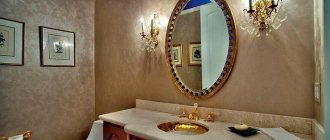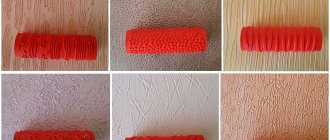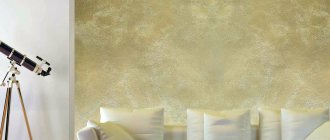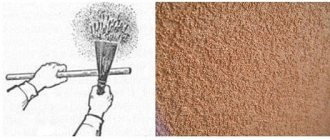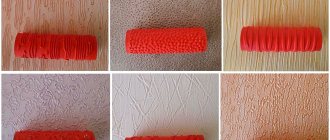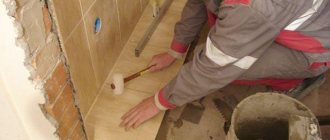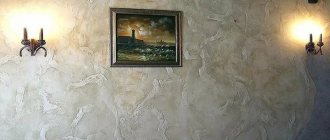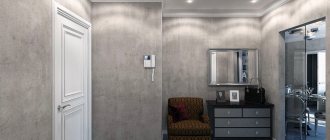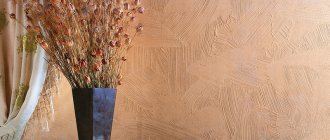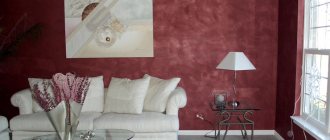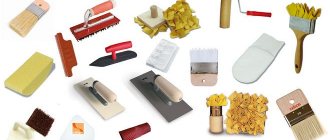Advantages
Despite the fact that structural bark beetle plaster requires certain skills to apply, is difficult to restore and is limited by seasonal application, it has a number of advantages, among which it is worth highlighting:
- The weight of the coating is insignificant; this is achieved due to the fact that the filler of the mixture is mineral chips. The bark beetle layer slightly loads the structure without causing its deformation or any changes.
- The raw materials used to produce the mixture are absolutely safe and do not affect human health or the environment in any way. Does not produce any emissions when exposed to high temperatures or rain.
- The stability of the coating compares favorably with analogues. High-quality plaster, tolerant to temperature changes, practically does not fade in direct sunlight and does not crack at high air temperatures.
- The bark beetle is distinguished by its durability, is not washed away by rain and is not susceptible to the development of mold and mildew.
- The strength of this plaster is not inferior to its analogues; it can withstand strong impacts without any significant changes in appearance.
- The cost of applying bark beetle is less than the price of analogues, such as decorative roller plaster.
- The design variability is not limited, since the base of the mixture is white, so it is possible, using coatings, to achieve any desired shade of finish.
Use in decoration
Bark beetle plaster for walls is available in three variations. According to application, it is divided into types:
- finishing of internal structures of the house;
- façade finishing;
- universal composition - used for treating walls inside and outside.
Plaster is sold ready-made in a specific color. Simply apply it to the surface and the finishing is done. The main disadvantage is the high price of the solution. As an analogue, dry mixtures packaged in bags are used. The powder is white. The tint is given by dyes that are added when stirring the solution.
The mixture has a dense structure. To mix colors efficiently, mixers and other machines are used. The color is selected using a computer. This is often done when it is necessary to update or remove defects in an existing coating.
To ensure high-quality coverage, it is necessary to properly stir the mixture and apply it to penoplex or other insulation.
Application area
Bark beetle façade plaster can be used not only for exterior but also for interior decoration. Thanks to its properties, it is easy to clean, even with the use of water and detergents.
For external work, bark beetle plaster for the facade is used to decorate and cover walls. Moreover, it is used both for decorating private houses and multi-storey office and residential buildings.
Bark beetle plaster for interior decoration is usually used to cover walls, decorate plasterboard arches and columns, and in some cases to decorate ceilings.
In any case, regardless of the area of application, such plaster performs its functions without losing functional features and advantages over analogues.
Wall coloring
The final drying times for the mixtures are indicated on the packaging. Usually this process takes two days indoors; outdoors everything happens faster. The completely dry surface should be treated with fine sandpaper. If the walls were finished with colored acrylic compounds, then the work can be considered completed.
Cement, silicone or silicate plaster bark beetles are painted with various compositions. It is better to carry out the work using a construction roller with long pile to paint the grooves. Perform movements in horizontal and vertical directions. If, after drying, you treat the wall with a dye with a less saturated color using a velor roller, you can get tinted grooves. It looks impressive and gives the interior originality.
Using a new method of decorating walls instead of boring wallpaper will require a lot of time and effort. You will have to purchase tools and master the profession of plasterer. The original stylish interior, durability and practical properties of the new coating will justify all the efforts and additional costs.
Types of bark beetle plaster
Based on the high popularity and variety of applications, bark beetle has many types, differing in scope, characteristics, composition and price.
The price range depends on the country of manufacture, components and characteristics. Therefore, choosing a mixture will not be difficult, regardless of financial capabilities and requirements for the finishing coating.
Depending on the scope of application, the following types are distinguished:
- for facade work;
- for interior work;
- universal purpose.
Depending on the composition, it happens:
- dry mixture produced in the form of mineral powder, which is used to make a solution;
- finishing paste, colored in various shades, ready for use without additional manipulation.
The choice of bark beetle composition depends on the client’s requirements and the scope of work. When covering a small area, it is better to use a ready-made paste of the desired color. For large-scale construction work, the choice primarily falls on dry plaster, since it is much more profitable due to the price and consumption of plaster, and allows you to independently select the color by adding dye.
There are also types of bark beetle plaster based on the filler base.
- Acrylic mixture. The base of the bark beetle is a polymer binder, namely acrylic. It has a number of advantages, among which is its high resistance to moisture. The surface of this bark beetle is elastic, which prevents mechanical damage, has an attractive appearance and is easily applied to the wall surface. This type is especially loved by specialists; it is most often used in rooms with high humidity, such as a bathhouse or a swimming pool.
- Silicate mixture. The basis for the production of this type is liquid glass. It has increased vapor permeability, is characterized by increased strength and protective properties, has an attractive appearance and variability in color.
- Mineral mixture. Produced by mixing quartz and cement. Most often used for facade work. This type of bark beetle is resistant to high temperatures, is not susceptible to frost, and does not burn.
Also, bark beetle plaster differs depending on the manufacturer. Experts highlight the most popular brands: ceresit ct 35 and ceresit ct 63. They differ in the grain size of the filler, but are used for decorative finishing of both internal and external coatings.
Types of compositions
Acrylic
Acrylic plaster "Bark beetle" is a special mixture for finishing, which includes acrylic resin . Advantages:
- strength;
- frost resistance;
- plastic;
- vapor permeability;
- resistance to temperature changes.
This type of coating is not susceptible to any mechanical or physical impacts. Even if the appearance is damaged, it is easy to restore. The unpretentiousness of the coating makes the work easy.
Acrylic “bark beetle” can be used at any low temperatures , and operation is possible in any weather conditions. Even if the house begins to crack due to temperature changes, such shrinkage will not harm the wall painting.
Attention
Most often, acrylic material is sold in the form of a ready-made mixture. This is very convenient, since the portioned components and the liquid base are already diluted in the required proportions, which means there is no reason to worry about the quality of the plaster application.
The compositions are coarse-grained, grain size is 2-2.5 mm. Before work, the surface must be well leveled. This condition is the key to correct application and retention of the pattern. The solution is created on acrylic resins, therefore it is plastic, with a rich palette. Strength and durability are the advantages of acrylic “Bark Beetle”.
Mineral
Mineral mixtures are sold in powder form . Inside there is a cement binder that needs to be diluted with water before work. Its difference from other plasters is that the mineral “Bark beetle” has a relatively low cost and is universal.
The grace of drying of the mineral layer differs greatly in characteristics from other compositions. With this base, you can form any patterns that will look advantageous against the background of other interiors.
Powdered mineral mixture can be used for both external and internal work .
To obtain the required consistency, you need to dilute the dry mixture with water. You need to follow the instructions to get results.
A slight drawback of the mineral mixture is hardness . Sudden temperature changes during operation and strong mechanical influences are contraindicated for such plaster. This type of coating should be treated with caution.
Facade for exterior work
The textured coating with a mass of grooves, stripes and pits imitates on the surface traces of the habitation of rodent insects in solid tree bark. This pattern makes the exterior interior rich and unusual. The advantage of using a pattern is to hide minor surface defects. Flaws in the walls and irregularities are masked by extraordinary ornaments.
It should be noted that there is a high percentage of the aesthetic component of such a coating. The surface, with significant inclusions, looks attractive, even solid .
“Bark beetle” plaster for façade cladding can be based on acrylic or gypsum base. The gypsum mixture is produced in powder form, and the acrylic mixture is produced in finished form.
Facing the facade with bark beetle plaster has a lot of advantages:
- The coating is light, so it does not create a load on the external walls.
- He is not afraid of high or low temperatures. This coating can be used in conditions of both northern and southern regions (withstands differences from minus 55 degrees to plus 60).
- The surface can be cleaned of dirt with a simple brush or vacuum cleaner.
- Rain, snow, and chemical compounds are not scary, so you don’t have to worry about the formation of mold and other deposits.
- After preparing the solution, it can be applied within 2-3 hours without fear of losing stability or color.
Advice
For external cladding work, it can be used for any type of coating. “Bark beetle” easily adheres to plaster, drywall, brick, concrete, chipboard. The texture and pattern of the surface are selected depending on the grain size, the skills of the painter, and the size of the tool with which the pattern is applied. The clarity of the contours will depend on the direction of the grooves and their thickness.
For interior decoration
Bark beetle plastering is often used to decorate interior walls. This is a quick way to transform a room. Finishing can be done in any area of the premises :
- in the bedroom;
- corridor;
- bathroom;
- living room;
- hallway;
- or in the children's room.
Surface:
- brick;
- concrete;
- cinder block;
- stone.
But there is an exception for interior work - drywall. The mixture can be placed on the gypsum board only after preliminary preparation of the base - applying a thick layer of putty.
Interior finishing is welcomed by “Bark Beetle” due to its ease of application, simple composition, and high performance qualities. The mixture is applied only to the walls. The porous surface does not adhere to the ceiling , and cannot be distributed evenly on the floor; it quickly shuffles when walking.
For interior decoration with this composition, you need to calculate the amount of mixture per square meter. The volume of material depends on the quality of the walls, their levelness, and the composition of the original coating. You can make an interesting coating with intricate figured ornaments; here you can add fresh ideas of modernity and classicism. Everything together will look just great. Innovations in approach and interpretation of species are limitless here.
Textured
Textured plaster "Bark beetle" has many advantages:
- The material is lightweight, and the granule size can be varied to suit any request. These points determine the wide range of applications of this type of plaster. The coating does not burden the walls of the building, making them neat and even.
- No aggressive components in the composition. This is an environmentally friendly material that can be used in residential premises with any degree of humidity and climatic conditions.
- The material is able to withstand any temperature changes.
- Fire resistance. When exposed to bright sunlight, it does not emit toxic and toxic substances.
- No chemical reaction with harmful compounds. With minor contact with chemicals, the design does not deteriorate.
- Durability. The peculiarity of this coating is its long service life. You can use any cleaning method: wet, damp or rough dry.
From potassium silicate
The silicate texture in the form of “Bark Beetle” plaster looks very elegant . The safe chemical composition, environmental friendliness and remarkable decorative qualities of the material allow us to call the composition universal. It is used in facade decoration and interior design.
Attention
Potassium silicate is a polymer or dispersion coating, the main binder of which is liquid glass. This is an aqueous alkaline solution of sodium silicate and potassium silicate. Additives - colored and mineral fillers in the form of sand, marble chips, crushed fragments of other rocks.
The silicate mass called “Bark Beetle” is sold in sealed buckets in the form of a ready-made solution. To properly apply the mass to the surface, you need to stir evenly and obtain a uniform consistency of the composition. Colored silicate-based plaster can also be produced as a single color. Most often, white paint is used as a basis. It can be tinted.
Working with silicate materials requires extreme caution . Alkali is added to the solution, which can easily harm health if it gets into the eyes or even onto the skin of the hands not protected by gloves. You need to protect your skin and wear safety glasses over your eyes.
Before applying the silicate base, the surface is covered with a thick layer of primer. Priming is carried out several times to ensure good adhesion and to saturate the walls to protect against excess moisture that can seep through the silicate layer.
Roller room
The textured material contains coarse-grained natural filler, which gives a beautiful relief to the design. Roller plaster "Bark beetle" is produced:
- Fine-grained . The grains are sold with a diameter of 1 to 1.5 mm.
- Medium grain . The grain diameter is 1.5–2 mm.
- Coarse-grained . The grains reach a size of 2.5 mm.
Roller plaster is characterized by high adhesion to different types of surfaces. The composition is perfectly applied, lasts a long time, and does not allow the formation of flaws if applied to concrete, plasterboard, brick and mineral surfaces. Other types of coatings must first be plastered with a thin layer to obtain good adhesion of the surface to the base.
Advice
When using the bark beetle silicate composition, it is enough to have a special grater or trowel as a handy tool. It can give the design a characteristic textured coating with an unusual pattern.
The composition in the dried state tolerates sudden temperature changes and strong humidity. Durability is a distinctive property of such a coating.
How to make bark beetle plaster
Plastering bark beetles with your own hands can be done at a fairly high level; you just need to follow the manufacturer’s instructions and the recommendations of a specialist. Each stage of the work is important, the sequence of which is usually presented as follows:
- Choosing a bark beetle. The choice depends on the type of working surface, volume of work, requirements for finished finishing, experience and financial capabilities.
- Preparation of the mixture. Preparation depends on the type of plaster chosen. Dry mixtures should be prepared following the recommendations and instructions on the packaging. Ready-made pastes can be used for application without special preparation.
- Preparatory work. Usually the wall is cleaned of dirt and construction dust, and then treated with a primer.
- Application of bark beetle. The application technique depends on many factors, but has general rules and principles.
- Painting the finished coating. Painting is carried out after the bark beetle has completely dried, using various methods. The type of paint and application technology are selected individually.
Types of design and color
The uniqueness of the “Bark Beetle” design is a huge advantage . A drawing that has already been made cannot be repeated exactly like the previous one. Designers and home owners strive to create a unique style, which is easily achieved with this mixture.
Types of design:
- Vertical cover or rain effect . It is achieved by making movements in different directions (up and down): touches and transitions imitate traces of raindrops.
- Circular coverings or imitation clouds . The spatula moves in a circle with slight pressure on the handle.
- Horizontal drawing . The movements should consist of guiding the spatula left/right.
- Chaotic ornament . The tool is carried along the wall in a chaotic manner. In this case, it is important to sharply and abruptly change the direction of movement of the instrument. This gives the drawing originality and uniqueness.
The initial base color of the Bark Beetle is pure white. The color scheme transforms it into the desired one. There are many shade variations. Their choice depends on the style and design of the room. The main condition for any design is the color type of the cladding. Harmony must be observed in all nuances - from the color of the roof to the compatibility of objects with each other.
Decorative plaster "Bark beetle" can achieve interesting interior styles:
- The effect of old walls . The surface is transformed by applying golden shades, silver and copper paints, highlighting the untouched part of the white color. This is a characteristic style for modern or antique.
- Craquelure . You can recreate the presence of decorative cracks that will visually attract attention. This is possible by adding pastel and light colors to the base color.
- Surface smoothness . A traditional option in a discreet format. Any combination of colors or tint reflections is appropriate here.
- Abstract roughness . The first base layer should be 1-2 shades darker. A light one is applied on top of it, which is imperceptibly rubbed into the base. It turns out that a random visual volume is created.
- Mother of pearl silk . Fresh and pastel colors look beautiful in combination with “Bark Beetle” when lining sleeping areas.
- Deep relief . Natural palettes are suitable for surfaces with a chaotic structure.
Material selection
When choosing a mixture, you should not first pay attention to the manufacturer. Of course, it is important, but the main thing is to choose a composition with the optimal structure, grain size and drying speed. The grain size directly affects the structure of the finish and its appearance, as well as material consumption.
When choosing a bark beetle, it is better to pay attention to ready-made mixtures. They significantly reduce the duration of work and are much easier to prepare and apply. But this type hardens quickly, and you won’t be able to use the leftovers. In such cases, it is better to purchase a dry mixture, preparing the working mixture of the required volume yourself. Moreover, dry plaster is much cheaper.
Based on the base of the mixture, it is better to choose acrylic plaster. It has many advantages, which offsets the rather high price. This bark beetle looks aesthetically pleasing and does not lose its properties over time.
Painting a plastered facade
The finished dried plaster surface is painted using acrylic or silicone paint. Acrylic-based dyes are used only two weeks after using the bark beetle. Silicone paints can be used three days after the façade is plastered.
Often the dyeing process is carried out in two stages. First, paint the entire surface. During work, grooves and other recesses are carefully painted over. At the second stage, the same paint is applied, but in a darker or lighter shade. It is used to paint only the upper part of the plaster, without affecting the grooves and pits.
Experts also use acrylic varnish to paint bark beetles. Manufacturers add coloring pigments or mother-of-pearl to this material. It is applied evenly over the surface. The work is carried out with a steel spatula.
Painting a plastered facade Source inves-stroy.ru
Preparing the mixture
Depending on the type of mixture, prep work may be required before application. Ready-made liquid mixtures can be used immediately, with just a little stirring. But the dry mixture requires some preparation.
Typically, each manufacturer places detailed instructions and recommendations for preparing the mixture on the plaster packaging. But, regardless of the manufacturer, there are a number of specific rules for mixing bark beetle plaster:
- First you need to prepare the required volume of clean water, to which the mixture is gradually added.
- It is very important that the water is at room temperature, as this significantly affects the quality of the finished plaster.
- When adding the dry mixture, the solution must be constantly stirred until it reaches a homogeneous consistency. It is important that there are no dry ingredients left in the mixture.
- Then the mixture should be left alone for a while, about half an hour, and stirred again.
It is important to prepare such a volume that after work there are no residues that dry out very quickly. Dried plaster cannot be reused.
Features of painting a plastered surface
Ready solutions have a certain color. Dry mixtures are available in white or gray shades. To give the coating color, dye is added when preparing the plaster. It is permissible to paint a finished textured finish. For this, the following compositions are used:
- silicone paint;
- water emulsion;
- acrylic paint.
Painting is carried out with a wide brush or roller. A mitten is also used. Use a roller to create a beautiful pattern. When applying paint, the grooves remain unpainted, which will express the texture. It is not recommended to use a spray gun, as the pattern will become less noticeable. All work is carried out very carefully. Before painting, excess paint is removed. This will prevent it from spreading and filling the grooves.
Preparatory work
Preparing the surface for applying the mixture is a very important stage, on which the quality of the coating, its strength and durability depend.
Preparatory work consists of several stages:
- Surface cleaning. The working area of the wall or ceiling must be completely clear of any contamination. It is very important to get rid of any traces of mold or mildew. The affected areas are completely cleaned and treated with an antiseptic.
- Leveling the wall. The surface should be as smooth as possible, since the bark beetle is not able to correct flaws. Cracks and large irregularities are covered with mortar.
- Applying primer. Treatment of the working surface is necessary to increase the adhesion of the plaster to the wall. It is recommended to select the type of primer individually for each type of mixture.
You can apply the starting composition, this will make the surface more even and prepared for applying the main layer.
How to apply decorative bark beetle plaster
The application of decorative bark beetle plaster is carried out with a regular spatula or trowel, and is practically no different from the application of other types of finishing coatings.
The application process is carried out according to certain rules:
- use a spatula to collect the required volume of the mixture and apply it to the trowel;
- the plaster must be applied from bottom to top, while holding the spatula at an angle of 60 degrees;
- the thickness of the layer is selected based on the grain size of the mixture;
- removal of excess;
- applying the pattern using a spatula using progressive movements.
Forming the pattern can begin after the mixture has dried a little. Depending on the air temperature, this will take from 5 to 30 minutes. To understand whether the wall is dry, you need to look at it from the side; if it does not shine from moisture, you can start working. Another option is to touch it with your finger and check that the mixture does not stick to it.
Apply the pattern with a polyurethane trowel, lightly pressing it onto the mixture. Movements must be performed strictly in the direction of the desired pattern. With a vertical pattern from bottom to top, with a circular pattern - respectively, circular, in a chaotic manner. The cross pattern is applied alternately with vertical and horizontal movements.
Within half an hour after forming the pattern, you can smooth the wall with a clean plastic trowel, without putting too much pressure on the pattern.
Applying bark beetle plaster with your own hands is easy to do, following the above rules. Bark beetle facade plaster requires drying before subsequent processing.
Application technology
Now we will analyze in detail how to correctly apply protective and decorative plaster “under the bark beetle”.
- The solution from the bucket is applied to the trowel.
- Apply the material using a bottom-up motion, starting from the corner of the wall. The thickness of the created decorative layer should not exceed the thickness of the filler grain. The entire amount of mixture on the trowel should be distributed over the surface in one movement of the hand. The remaining solution from the tool is thrown back into the bucket, because they contain fewer marble grains.
Leveling the mixture on the wall - It takes 20-25 minutes to plaster one area. Then you need to rub over the plaster - give it texture, create grooves. To ensure that work is not interrupted and the prepared solution does not dry out, it is recommended that two people complete the finishing process. One person applies and levels the mixture, the second one rubs it in after him.
- The texture of the bark beetle is created using a PVC grater. The tool is applied to the wall and, with light pressure, made in a circular motion. Marble granules are rolled under a grater and leave grooves on the surface of the plaster. To get the “rain” effect, you need to rub vertically or at a slight angle. Horizontal movements of the grater will, accordingly, leave horizontal stripes on the surface.
Grout options - The finish is left until completely dry. Can be painted after 48 hours.
Finishing the facade using insulation
It is possible to finish the external walls of a house using this decorative plaster not only on load-bearing bases. Often plastering is carried out using the “wet facade” technology, when the material is placed on a layer of insulation.
You can learn more about this technology using the link above. Briefly the process looks like this:
- Thermal insulation (mineral wool, polystyrene foam, Penoplex) is attached to the hard surface of the wall using a special adhesive for insulation.
- The adhesive composition is applied again on top of the insulation. The reinforcing mesh is pressed into it, smoothed, completely immersed in the solution.
- Use a trowel or a tile spatula with jagged edges to create horizontal stripes on the surface of the adhesive. This is necessary for better adhesion to the decorative layer.
- After three days, the facade can be plastered “under bark beetle” using the technology described above.
For external walls, it is better to choose mixtures with a coarse grain of 2.5 mm or more, so that the texture of the finish is not lost at a distance.
Decoration of the facade
Video master class
The video tutorial below shows how to decorate façade walls with your own hands. Pay attention to the master’s comments; he talks about important nuances in working with this textured plaster.
Painting bark beetle plaster
You can get the desired color in two ways: by adding dye to the mixture when preparing and painting the dried plaster. Usually the bark beetle is painted after applying it to the wall, since this method is much easier and makes it easier to choose a shade.
Before painting, you need to wait at least a day so that the surface is completely dry.
Painting is done using a brush and roller. The first layer is applied with a brush, and it is very important that the paint penetrates into the recesses. Then use a sponge to remove excess paint. The second coat is applied with a short-nap roller, which should be used to apply a thin layer so that the paint does not fill the grooves. It is advisable to make quick forward movements. This creates a two-color pattern, creating the illusion of depth.
Video description
An interesting method of installing metal limiting beacons is described in the following video:
Limiters can also be installed on a solution. More often they use a gypsum mixture, which takes less time to dry. It is also applied under the beacons approximately every 300 mm. The limiters are recessed flush into the solution.
Applying base plaster
First, the solution is applied using a wide spatula. The thickness of this layer should slightly exceed the depth of the beacons. Then they use a rule to level the surface.
Then the limiting beacons are removed. The operation is performed before the base layer of plaster hardens. Then the recesses from the beacons are sealed with the same solution.
Facade cladding “Bark beetle”
Before applying bark beetle to the exterior of the house, you need to study the cladding technology. The process is always performed on a previously prepared surface. Its quality affects the texture of the cladding pattern, which is characteristic of this finish.
The plaster composition is applied by professionals using a stainless steel spatula and a plastic trowel. During plastering, specialists also often use a trowel.
Using tools when plastering Source sandors.ru
Typically, cladding begins from the bottom of the wall. The mixture is applied in small portions onto a spatula. Then it is evenly stretched over the surface. The thickness of the layer is created no less than the size of the marble grain, and the tool is held at an angle of 60° relative to the base being tiled. The plaster composition is distributed in a horizontal or vertical direction.
